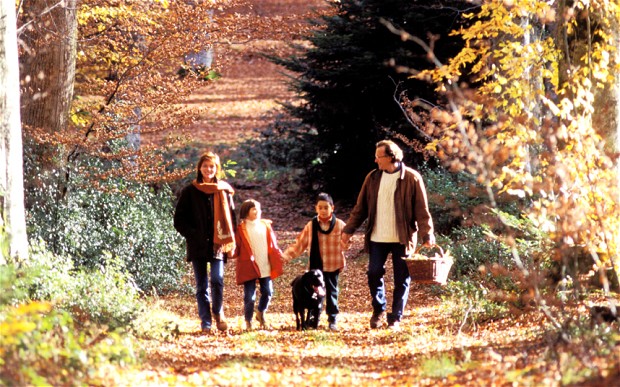
Families enjoying the centuries-old countryside pleasure of wandering through the woods and looking for wild mushrooms are being beaten to it by "greedy" commercial pickers, the National Trust has said.
There's a shortage of mushrooms this autumn because of the poor summer, so professionals are in line for big profits if they can collect enough to sell to top restaurants, hotels and supermarket chains, the National Trust has said.
In the New Forest, the charity's Countryside Team has discovered vast tracts of its land has been completely stripped of edible mushrooms.
The Trust says commercial picking on a large scale is ruining a day out for families - and the professional gangs of fungi hunters are also damaging the environment.
One volunteer, Roger Newton, said: "Not only was every single edible mushroom taken or cut, just leaving the stalk, but the ground had been badly trampled.
"Taking mushrooms like this stops the fruiting body's ability to release its millions of spores each day and the trampling compresses the ground, damaging the places where they like to grow.
"There is also the danger that someone gathering mushrooms in this quantity could take poisonous varieties, with dire consequences for those eating them."
The National Trust is the second largest landowner in the New Forest, with 2,400 hectares (5,900 acres) on five different sites.
Lee Hulin, one of the Trust's outdoor rangers, said: "Our commons are there for everybody, so we are increasingly saddened that large scale harvesting limits the chance of seeing these lovely mushrooms for regular visitors.
"This sort of plundering is spoiling enjoyment for everyone."
The warm, dry spring, the wettest summer for 100 years and a dry autumn has led to a shortage of mushrooms across the British countryside, so the professionals are swarming to places like the New Forest where they can still expect to find enough fungi to make picking commercially wothwhile.
Prices in the shops are soaring because even imports have been hit by 2012's unusual weather and mushrooms the world over are growing at the "wrong" time of the year.
The amount paid varies from year to year but experts say commercial pickers can expect to make a profit of at least £20 per kilo.
The National Trust says the latest wholescale blitz by professional pickers in the New Forest saw the area around Bramshaw Common cleared of its mushrooms.
Experts say the New Forest is home to thousands of species and is regarded as one of the best areas in the UK for fungi.
Commercial mushroom picking is banned in the Forest.
The only person allowed to do it is Brigitte Tee-Hillman,65, who won a landmark ruling against the Forestry Commission in 2006.
A Commission spokeswoman said "People picking mushrooms should only take enough for personal consumption.
This means no more than 1.5kg per visit, and no more than half the fruiting bodies of any one species."
But demand is at a premium because of the wet summer.
Brigitte Tee-Hillman said "Unless we get rain, rain, rain, we are not going to have any mushrooms.
"We need a lot of penetrating rain to rescue the season, but I don't think we're going to get it.
"Since I got my licence to pick mushrooms 33 years ago I have never known it so bad.
"This year the seasons have all been mixed up. Spring was in the winter, summer in the spring and autumn in the summer.
"The dry, warm spring, wet summer and dry autumn have meant a lack of mushrooms. And we have had three ground frosts, which hasn't helped.
"Usually at this time of year everything would be growing, but there is just one here, one there. We had no St George's mushrooms at all earlier in the year and the strange seasons have continued.
"But this is nature, and next year will probably be a bumper season. Brown Chanterelles, hedgehog mushrooms and horn of plenty are all missing.
"The places I supply to are not getting any locally grown ones, and the imported mushrooms are also coming in at different times of the year."
John Wright, a field mycologist who wrote celebrity chef Hugh Fernley Whittingstall's River Cottage book on mushrooms, said the problem was with quantity.
He said "There has been a lot of variety, but the quantity has been poor. The problem is that all the rain came in blocks and although the summer rain was good, there was a six or seven week period this autumn without any rain.
"The mycelium - the long strands that grow underground - need the rain. But fungi do not need to produce mushrooms to survive.
"Like an apple tree doesn't need to produce apples, fungi don't need to produce mushrooms. And this year they haven't.
"Last year was excellent so the fungi might also have used up their resources. The commercial pickers will certainly be struggling."
Ken Roberts, from the Dorset Fungi Group, agreed that it was a poor season, but said interest remained high among amateur enthusiasts.
He said "It has been poor so far, but there are signs that it is picking up. However, some varieties have been very thin on the ground. The parasol, cauliflower fungus, amethyst, field mushroom and horse mushrooms are all scarce.
"I haven't seen many of the cep mushroom Boletus edulis, which is the main constituent of dried mushrooms that you buy for soups.
"The National Trust is running a survey to log the number of wax cap mushrooms - and we haven't seen many of those about.
"But interest in mycology seems to be growing and for our fungi forays numbers are well up on last year."
























